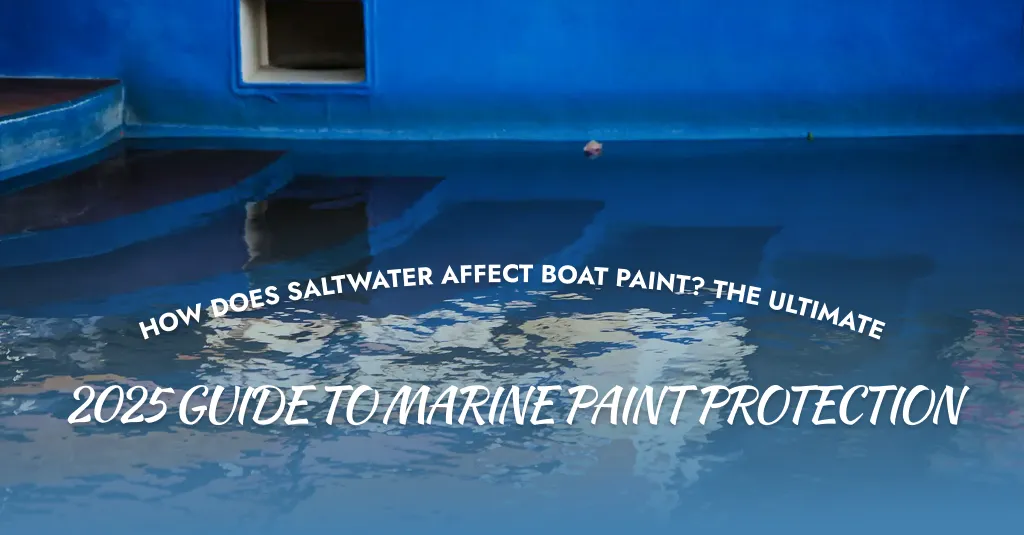
How Does Saltwater Affect Boat Paint? The Ultimate 2025 Guide to Marine Paint Protection
Owning a boat is one of life’s greatest pleasures, endless days on sparkling water, fishing trips, island hopping, and sunset cruises. But ask any boat owner what their biggest maintenance headache is, and they’ll likely say the same thing: saltwater.
One of the most common and costly questions new boat owners have is: how does saltwater affect boat paint? The short answer is: more than you think!
Saltwater is beautiful but brutal. If you don’t protect your boat’s paint and finish, salt can eat away at it, leading to fading, peeling, blistering, and corrosion that costs big money to fix.
So let’s break it down. In this complete 2025 guide, you’ll learn how does saltwater affect boat paint, why it happens, what to watch for, how to maintain your boat’s protective layers, and the smart steps you can take to keep your boat looking shiny and shipshape for years.
How Does Saltwater Affect Boat Paint? The Basics
Saltwater is highly corrosive. When salt sits on your boat’s paint, it:
- Breaks down the paint’s protective barrier.
- Attracts and holds moisture, accelerating corrosion.
- Encourages oxidation that dulls and damages the paint.
- Causes blistering, cracking, and peeling over time.
So, how does saltwater affect boat paint? In every way possible from dull finishes to deep structural rust if left untreated.
Why Is Salt So Hard on Boat Paint?
To understand how does saltwater affect boat paint, you need to know how salt behaves:
- Salt is hygroscopic it pulls moisture from the air. When salty spray lands on your hull, it traps water against the surface.
- Moisture + oxygen + metal underneath the paint equals corrosion.
- Salt crystals can scratch the paint’s surface if not washed away gently.
- UV rays amplify the damage by breaking down paint binders, making it easier for salt and moisture to penetrate.
So even if you can’t see it yet, salt is always working to damage your boat’s protective coatings.
Where Is Salt Damage Most Common?
Salt damage isn’t limited to the hull. Here’s where salt hits hardest:
Hull & Waterline: Constant exposure to salt spray and splashes.
Deck & Rails: Salt mist carried by wind settles here.
Trim & Metal Fixtures: Salt causes corrosion, rust stains, and paint bubbling.
Underside: Salt sticks to the bottom paint too barnacles, algae, and corrosion love salt.
Engine & Compartments: Salt creeps into cracks, causing hidden corrosion under painted surfaces.
Freshwater vs. Saltwater: A World of Difference
If you’ve only boated in freshwater lakes or rivers, you might wonder, how does saltwater affect boat paint compared to freshwater?
Here’s the difference:
Freshwater: Less corrosive. Minimal salt residue. Paint lasts longer with basic care.
Saltwater: Constant assault. Even a day on the ocean leaves a salty film that eats away at paint and metal if not rinsed off.
Common Signs of Saltwater Paint Damage
How do you know if your paint is suffering?
Look for these salt damage clues:
Chalky or Faded Paint: Oxidation caused by sun and salt breaks down the paint’s gloss.
Peeling & Bubbling: Trapped salt moisture under the paint causes blistering.
Rust Spots: Where paint cracks or chips, saltwater reaches bare metal and rust appears.
Streaks & Spots: White salty residue or salt crystals that cling to the surface.
How Does Saltwater Affect Boat Paint Long-Term?
When ignored, salt damage doesn’t just ruin your boat’s good looks it shortens its lifespan.
Left untreated, salt damage can:
- Eat through paint to expose fiberglass or metal.
- Lead to rust, which can weaken your hull.
- Cause costly structural repairs.
- Reduce resale value dramatically.
Proper maintenance is much cheaper than repainting or major repairs!
How to Protect Boat Paint from Saltwater
So, how do you fight back?
Here’s the good news: modern marine paints and coatings are designed to stand up to salt if you care for them properly.
Wash Regularly
After every saltwater trip, rinse your boat thoroughly with fresh water. A gentle soap removes salt film.
Use Quality Marine Paint
Invest in high-grade marine paint designed for saltwater exposure not just any paint will do.
Wax & Seal
Waxing your boat adds a layer of protection. Marine-grade wax helps repel salt and UV rays.
Anti-Fouling Bottom Paint
For hulls, use anti-fouling paint. It prevents marine growth that traps salt and moisture.
Cover Your Boat
When docked, use covers for exposed areas. Less salt exposure means less damage.
Store Properly
Haul out and store your boat in dry dock or under cover when not in use for long periods.
Choosing the Right Marine Paint
Not all paints are created equal. To limit how saltwater affects boat paint, choose:
Epoxy Primers: Strong barrier against moisture.
Polyurethane Topcoats: Durable, glossy finish that resists UV and salt.
Anti-Fouling Paint: For the hull below the waterline, preventing barnacles and salt buildup.
Consult a marine paint expert if you’re unsure the right paint saves you big headaches.
How Does Saltwater Affect Boat Paint on Aluminum vs. Fiberglass?
Salt doesn’t discriminate, but different hull materials react differently:
Fiberglass Boats: Salt breaks down gelcoat over time, leading to oxidation. Regular waxing protects it.
Aluminum Boats: Saltwater causes galvanic corrosion if the paint layer is damaged. Once paint chips, bare aluminum is vulnerable.
Wood Boats: Older wooden boats need constant sealing to keep salt from penetrating the wood grain.
How Does Saltwater Affect Boat Paint During Storage?
Even when docked or stored near the coast, salt can settle on your boat.
- Cover your boat.
- Wash it even when not in use.
- Check seals and paint for cracks that let salt in.
Pro Tips: Extending the Life of Boat Paint
Experts agree: the key is consistent care.
Rinse After Every Trip: Even a quick hose-down removes salt crystals.
Use a Soft Brush: Hard brushes scratch paint, allowing salt to penetrate.
Inspect & Touch Up: Fix paint chips quickly before saltwater finds its way in.
Apply Protective Coatings: Ceramic coatings are popular for extra protection.
Hire a Pro Detailer: A seasonal detail removes built-up salt and polishes the paint.
DIY: How to Remove Salt Stains from Boat Paint
Stubborn salt spots? Try this:
- Rinse with fresh water.
- Mix a mild boat soap and warm water.
- Gently scrub with a soft sponge.
- Dry completely to avoid water spots.
- Wax for added protection.
Real Boater Stories
Tom’s Coastal Cruiser:
Tom lives aboard a 32-foot fiberglass cruiser on Florida’s Gulf Coast. Early on, he didn’t realize how does saltwater affect boat paint. Within a year, faded patches and rust spots appeared. Now, he washes weekly, uses ceramic coatings, and hasn’t had to repaint in 5 years.
Linda’s Fishing Skiff:
Linda fishes offshore every weekend. Her aluminum skiff had paint bubbles from salt corrosion. She learned the hard way: one missed rinse can cost thousands in repainting. She now carries a portable freshwater tank for rinses right at the dock.
Next-Level Protection: Ceramic Coatings
Want to level up? Many boat owners now use ceramic coatings to fight saltwater paint damage.
- Forms a nano-layer over paint.
- Repels salt, dirt, UV rays.
- Lasts longer than wax.
- Makes washing easier.
It’s an investment but worth it for long-term protection.
What If You Already Have Salt Damage?
If your boat paint is chalky, peeling, or rusted, don’t panic:
Wash & Dry: Remove all salt residue.
Polish & Buff: Bring back shine if oxidation is light.
Repaint: For severe damage, sand down and repaint with marine-grade products.
Consult a Pro: Boat yards specialize in saltwater repairs.
Saltwater & Bottom Paint
Don’t forget below the waterline! The hull’s anti-fouling paint faces constant salt exposure.
- Inspect yearly.
- Reapply anti-fouling paint every 1–3 years.
- Keep the hull clean to prevent salt-trapped growth.
The Cost of Ignoring Salt Damage
Ignoring salt’s impact is costly. Repainting a 30-foot boat hull can cost $5,000–$15,000. A simple wash and wax routine costs a fraction of that!
So, how does saltwater affect boat paint? Now you know: salt never sleeps! It’s always working to corrode your paint, fade your shine, and cost you money.
The good news? With the right knowledge, products, and care routine, your boat can stay bright and protected for years.
So wash it, wax it, check it then get back out on the water and enjoy the adventure, salt spray and all!
Frequently Asked Questions (FAQs)
How often should I wash my boat after saltwater use?
Ideally, every trip. Rinse thoroughly with fresh water.
Can salt damage gelcoat?
Yes. Salt degrades gelcoat over time, causing dullness and oxidation.
Does waxing help protect boat paint from saltwater?
Absolutely waxing seals pores and makes it harder for salt to stick.
How long does marine paint last in saltwater?
Quality marine paint can last 5–7 years with proper care but neglect can cut that in half.
Can I use car wax on my boat?
Use waxes designed for marine environments they handle salt and UV better.





